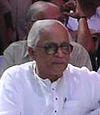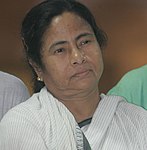This is an old revision of this page, as edited by Lihaas (talk | contribs) at 19:44, 10 May 2011 (see talk page , per [[WP:BRD[[ consensus is needed furthermore SOURCED info was removed for unsourced info and this is about to be a current event so sourcing has to be tight). The present address (URL) is a permanent link to this revision, which may differ significantly from the current revision.
Revision as of 19:44, 10 May 2011 by Lihaas (talk | contribs) (see talk page , per [[WP:BRD[[ consensus is needed furthermore SOURCED info was removed for unsourced info and this is about to be a current event so sourcing has to be tight)(diff) ← Previous revision | Latest revision (diff) | Newer revision → (diff)
| |||||||||||||||||||
All 294 seats in the West Bengal legislative assembly | |||||||||||||||||||
|---|---|---|---|---|---|---|---|---|---|---|---|---|---|---|---|---|---|---|---|
| |||||||||||||||||||
| |||||||||||||||||||
The West Bengal legislative assembly election, 2011 is scheduled to occur in April-May 2011 in six phases for 294 seats in the Vidhan Sabha. The Communist Party of India (Marxist)-led Left Front won the previous election with Buddhadev Bhattacharya serving as Chief Minister.
Background
This will be the first legislative assembly election since political agitations in Nandigram and Singur led by opposition leader Mamata Banerjee caused deaths by police firing amidst protests.
It also follows the defeat of the Left Front, who have ruled West Bengal since 1977, in the Indian general election, 2009, as well as its relatively poor showing in panchayat and municipal elections.
Delimitation
Main article: Delimitation Commission of IndiaThe 2011 election adopted re-drawn electoral constituencies based on the 2001 census, following the 2002 Delimitation Commission of India, whose recommendations were approved in February 2008.
Polling schedule

Chief Election Commissioner of India S. Y. Quraishi announced that polling in West Bengal will be spread over six phases between 18 April and 10 May for the constituencies of the West Bengal Vidhan Sabha.
| Date | No of assembly constituencies | Status | ||
| Phase I | 18 April | 54 | ||
| Phase II | 22 April | 50 | ||
| Phase III | 27 April | 75 | ||
| Phase IV | 3 May | 63 | ||
| Phase V | 7 May | 38 | ||
| Phase VI | 10 May | 14 | ||
| Counting | 13 May | 294 | ||
| Source: Election Commission of India | ||||
Phase I
54 constituencies went to the polls:
Mekliganj (SC), Mathabhanga (SC), Coochbehar Uttar (SC), Coochbehar Dakshin, Sitalkuchi (SC), Sitai (SC), Dinhata, Natabari, Tufangunj, Kumargram (ST), Kalchini (ST), Alipurduars, Falakata (SC), Madarihat (ST), Dhupguri (SC), Mayanaguri (SC), Jalpaiguri (SC), Rajganj (SC), Dabgram-Fulbari, Mal (ST), Nagrakata (ST), Kalimpong, Darjeeling, Kurseong, Matigara-Naxalbari (SC), Siliguri, Phansidewa (ST), Chopra, Islampur, Goalpokhar, Chakulia, Karandighi, Hemtabad (SC), Kaliaganj (SC), Raiganj, Itahar, Kushmandi (SC), Kumarganj, Balurghat, Tapan (ST), Gangarampur (SC), Harirampur, Habibpur (ST), Gazole (SC), Chanchal, Harishchandrapur, Malatipur, Ratua, Manikchak, Maldaha (SC), English Bazar, Mothabari, Sujapur and Baisnabnagar.
Phase II
50 constituencies went to the polls:
Farakka, Samserganj, Suti, Jangipur, Raghunathganj, Sagardighi, Lalgola, Bhagaban Gola, Raninagar, Murshidabad, Nabagram (SC), Khargram (SC), Burwan (SC), Kandi, Bharatpur, Rejinagar, Beldanga, Baharampur, Hariharpara, Naoda, Domkal, Jalangi, Karimpur, Tehatta, Palashipara, Kaliganj, Nakashipara, Chapra, Krishnanagar Uttar, Nabadwip, Krishnanagar Dakshin, Santipur, Ranaghat Uttar Paschim, Krishnaganj (SC), Ranaghat Uttar Purba (SC), Ranaghat Dakshin (SC), Chakdah, Kalyani (SC), Haringhata (SC), Dubrajpur (SC), Suri, Bolpur, Nanoor (SC), Labpur, Sainthia (SC), Mayureswar, Rampurhat, Hansan, Nalhati and Murarai.
Phase III
75 constituencies went to the polls:
Bagdah (SC), Bongaon Uttar (SC), Bongaon Dakshin (SC), Gaighata (SC), Swarupnagar (SC), Baduria, Habra, Ashoknagar, Amdanga, Bijpur, Naihati, Bhatpara, Jagatdal, Noapara, Barrackpur, Khardaha, Dum Dum Uttar, Panihati, Kamarhati, Baranagar, Dum Dum, Rajarhat New Town, Bidhan Nagar, Rajarhat Gopalpur, Madhyamgram, Barasat, Deganga, Haroa, Minakhan (SC), Sandeshkhali (ST), Basirhat Dakshin, Basirhat Uttar, Hingalganj (SC), Gosaba (SC), Basanti (SC), Kultali (SC), Patharpratima, Kakdwip, Sagar, Kulpi, Raidighi, Mandirbazar (SC), Jaynagar (SC), Baruipur Purba (SC), Canning Paschim (SC), Canning Purba, Baruipur Paschim, Magrahat Purba (SC), Magrahat Paschim, Diamond Harbour, Falta, Satgachia, Bishnupur (SC), Sonarpur Dakshin, Bhangore, Kasba, Jadavpur, Sonarpur Uttar, Tollygunj, Behala Purba, Behala Paschim, Maheshtala, Budge Budge, Metiabruz, Kokata Port, Bhabanipore, Rashbehari, Ballygunge, Chowrangee, Entally, Beleghata, Jorasanko, Shyampukur, Maniktala and Kashipur-Belgachia.
Phase IV
63 constituencies went to the polls:
Bally, Howrah Uttar, Howrah Madhya, Shibpur, Howrah Dakshin, Sankrail (SC), Panchla, Uluberia Purba, Uluberia Uttar (SC), Uluberia Dakshin, Shyampur, Bagnan, Amta, Udaynarayanpur, Jagatballavpur, Domjur, Uttarpara, Sreerampur, Champdani, Singur, Chandannagore, Chunchura, Balagarh (SC), Pandua, Saptagram, Chanditala, Jangipara, Haripal, Dhanekhali (SC), Tarakeswar, Pursurah, Arambag (SC), Goghat (SC), Khanakul, Tamluk, Panskura Purba, Panskura Paschim, Moyna, Nandakumar, Mahisadal, Haldia (SC), Nandigram, Chandipur, Patashpur, Kanthi Uttar, Bhagabanpur, Khejuri (SC), Kanthi Dakshin, Ramnagar, Egra, Bardhaman Dakshin, Jamalpur (SC), Monteswar, Kalna (SC), Memari, Bardhaman Uttar (SC), Bhatar, Purbasthali Dakshin, Purbasthali Uttar, Katwa, Ketugram, Mangalkot and Ausgram (SC)
Phase V
38 constituencies went to the polls:
Dantan, Keshiary (ST), Kharagpur Sadar, Narayangarh, Sabang, Pingla, Kharagpur, Debra, Daspur, Ghatal (SC), Chandrakona (SC), Keshpur (SC), Purulia, Manbazar (ST), Kashipur, Para (SC), Raghunathpur (SC), Saltora (SC), Chhatnam, Bankura, Barjora, Onda, Bishnupur, Katulpur (SC), Indus (SC), Sonamukhi (SC), Khandaghosh (SC), Raina (SC), Galsi (SC), Pandabeswar, Durgapur Purba, Durgapur Paschim, Raniganj, Jamuria, Asansol Dakshin, Asansol Uttar, Kulti and Barabani.
Phase VI
14 constituencies will go to the polls:
Nayagram (ST), Gopiballavpur, Jhargram, Garbeta, Salboni, Medinipur, Binpur (ST), Bandwan (ST), Balarampur, Baghmundi, Joypur, Ranibangh (ST), Raipur (ST) and Taldangra.
Issues
Land reform
| This section needs expansion. You can help by adding to it. (April 2011) |
Following the general election, with the TMC being an important part of the central government's coalition, the central government eased its controversial land acquisition policy for Special Economic Zones. Part of the proposal was that the government would not get involved in land acquisition for private organisations. One official from the central ruling coalition was quoted as saying that "There is a tacit understanding between these two critical allies that there will be no decision on the Land Acquisition Bill until the results of West Bengal state elections are clear." The issue of land acquisition for development also created a battle zone like situation in the villages between armed cadres of the ruling CPM and the Maoists.
Gorkhaland
During the general election the issue of the founding of Gorkhaland as seperate from West Bengal gained prominence along with the victory of Jaswant Singh from Darjeeling consituency for the Bharatiya Janata Party and supported by the Gorkha Janmukti Morcha (which supports an independent Gorkhaland for ethnic Nepalis as opposed to ethnic Bengalis).
Since the election the issue again cropped up as demands for a Telengana grew. During this election CM Bhattacharjee said that Gorkhaladn should not be seperated but instead a additional development of the region should occur. He said in Lichupokhri that the agitators should "stop your movement for a Gorkhaland. It will never be fulfilled. Concentrate on all round development of Darjeeling as it is the only solution to the issue."
Election
On 17 April, the Election Commission of India made an appeal for all registered voters to turn out for their respective electoral dates.
References
- Assembly Election Schedule 2011
- "Buddha fights the big Mamata surge - The Times of India". indiatimes.com. 2011 . Retrieved 25 April 2011.
{{cite web}}: Check date values in:|year=(help)CS1 maint: year (link) - "gazette123.pdf (application/pdf Object)" (PDF). ceowestbengal.nic.in. 2007 . Retrieved 25 April 2011.
{{cite web}}: Check date values in:|year=(help)CS1 maint: year (link) - "West Bengal Assembly Election 2011 Dates". www.westbengalelections2011.com. Retrieved 2011-03-01.
- "ac_elec_schedule_2011.pdf (application/pdf Object)" (PDF). ceowestbengal.nic.in. 2011 . Retrieved 25 April 2011.
{{cite web}}: Check date values in:|year=(help)CS1 maint: year (link) - "Forbes India - 2011 West Bengal State Elections' Impact on Land Reforms". business.in.com. 2011 . Retrieved 25 April 2011.
{{cite web}}: Check date values in:|year=(help)CS1 maint: year (link) - "Bengal intellectuals urge Chidambaram to help disarm Harmad Vahini - Times Of India". articles.timesofindia.indiatimes.com. 2011 . Retrieved 25 April 2011.
{{cite web}}: Check date values in:|year=(help)CS1 maint: year (link) - http://articles.timesofindia.indiatimes.com/2011-02-20/india/28625487_1_gorkhaland-separate-state-gjm
- "Appeal16042011.pdf (application/pdf Object)" (PDF). eci.nic.in. 2011 . Retrieved 25 April 2011.
{{cite web}}: Check date values in:|year=(help)CS1 maint: year (link)
| Elections in West Bengal | |||||
|---|---|---|---|---|---|
| General elections | |||||
| Legislative Assembly | |||||
| Local elections |
| ||||
| Elections in India | |||||

